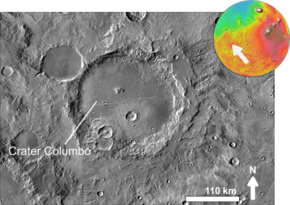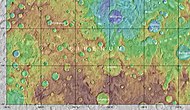 Columbus crater based on THEMIS day-time image | |
| Planet | Mars |
|---|---|
| Coordinates | 29°48′S 166°06′W / 29.8°S 166.1°W |
| Quadrangle | Memnonia |
| Diameter | 119 km |
| Eponym | Christopher Columbus, Italian explorer (1451-1506) |
Columbus is a crater in the Terra Sirenum of Mars. It is 119 km in diameter and was named after Christopher Columbus, Italian explorer (1451–1506).[1][2] The discovery of sulfates and clay minerals in sediments within Columbus crater are strong evidence that a lake once existed in the crater.[3][4] Research with an orbiting near-infrared spectrometer, which reveals the types of minerals present based on the wavelengths of light they absorb, found evidence of layers of both clay and sulfates in Columbus crater. This is exactly what would appear if a large lake had slowly evaporated.[5][6] Moreover, because some layers contained gypsum, a sulfate which forms in relatively fresh water, life could have formed in the crater.[7]
-
Map showing the relative positions of Columbus crater and other nearby craters in Memnonia quadrangle
- ^ "Gazetteer of Planetary Nomenclature | Columbus". usgs.gov. International Astronomical Union. Retrieved 4 March 2015.
- ^ "Google Mars".
- ^ "Sulfates and Clays in Columbus Crater, Mars". 24 July 2018.
- ^ Cite error: The named reference
ehlmannwas invoked but never defined (see the help page). - ^ Cabrol, N. and E. Grin (eds.). 2010. Lakes on Mars. Elsevier.NY.
- ^ Wray, J. et al. 2009. Columbus Crater and other possible paleelakes in Terra Sirenum, Mars. Lunar and Planetary Science Conference. 40: 1896.
- ^ "National Geographic". Archived from the original on December 5, 2009.
